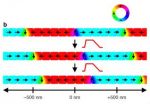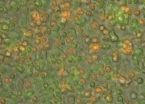(Press-News.org) Researchers at Johannes Gutenberg University Mainz (JGU) have achieved a major breakthrough in the development of methods of information processing in nanomagnets. Using a new trick, they have been able to induce synchronous motion of the domain walls in a ferromagnetic nanowire. This involved applying a pulsed magnetic field that was perpendicular to the plane of the domain walls. "This is a radically new solution," explained Professor Mathias Kläui of the Institute of Physics of Johannes Gutenberg University Mainz. "It enables us to move domain walls synchronously over a relatively large distance without them returning to their original position." This is essential for permanent data storage, because data would otherwise be lost if domain walls were not collectively displaced in a controlled manner. The research was carried out in cooperation with the working groups of Professor Stefan Eisebitt at TU Berlin and Professor Gisela Schütz of the Max Planck Institute for Intelligent Systems in Stuttgart. The results were published in the journal Nature Communications at the end of March.
Magnetic nanowires have small regions of uniform magnetization called domains, which can be used as storage units (bits). The site where domains of different alignment meet each other is called a domain wall. Information can be stored in the domain, and read and processed by means of the movement of the domain walls. The method has the great advantage that the information – as in the case of magnetic data storage in general – cannot be easily lost. This contrasts with semiconductor-based storage systems, such as RAM in PCs, which lose all stored information without power. In addition, no fragile moving parts are required such as the read/write head of a hard disk.
It has not previously proved possible to induce the required controlled and synchronized movement of multiple domain walls using magnetic fields. The most obvious approach would be to apply a magnetic field in the direction in which the magnetization runs in the tiny nanowires. However, this has been shown to be ineffective, as there is loss of data. Mathias Kläui and his group took a radically new path. They decided to apply a pulsed magnetic field perpendicularly to the in-plane magnetized domain walls. As the Mainz researchers found in their model system, it is possible to customize the asymmetric field pulses that provide the forward- and backward-oriented forces that act on domain walls. Data can thus be moved within the storage medium in a controlled manner.
The participating physicists at Mainz University first tried out their concept in the context of micromagnetic simulations and then tested it experimentally. For this purpose, they recorded images of the magnetic arrangement in the tiny nanowires with the help of the electron storage ring BESSY II of the Helmholtz Center Berlin for Materials and Energy (HZB). As expected from the simulation, they observed displacement of the domain walls in a direction that was consistent with the model. The scientists also calculated the energy that would be necessary for the experimentally observed domain wall motion and came to the conclusion that the energy consumption of the proposed system would be quite cost-effective compared with the best components currently available.
"The results are very promising. We assume that the necessary paradigm shift will be facilitated by this new approach and it will prove possible to develop a method of efficient and controlled synchronous motion of the domain walls in nanowires," said Kläui. This would pave the way for the development of non-volatile spintronic components of the next generation, which could be used in a wide range of applications for data storage as well as logic and sensor modules.
INFORMATION: END
Domain walls in nanowires cleverly set in motion
Domain walls can be synchronously displaced using magnetic field pulses / An important prerequisite for the development of nano-components for data storage and sensor technology
2014-04-08
ELSE PRESS RELEASES FROM THIS DATE:
Montreal researchers explain how our immune system kills abnormal blood cells
2014-04-08
A team of researchers at the IRCM, led by André Veillette, MD, explains how our immune system kills abnormal blood cells. Their discovery, recently published in the Journal of Experimental Medicine, could eventually lead to new treatment avenues for leukemia, lymphoma and certain types of infectious viral diseases.
"Our team is studying how natural killer cells can eliminate abnormal hematopoietic (blood) cells," explains Dr. Veillette, Director of the Molecular Oncology research unit at the IRCM. "NK (natural killer) cells are crucial to the immune system and play a ...
How coughs and sneezes float farther than you think
2014-04-08
The next time you feel a sneeze coming on, raise your elbow to cover up that multiphase turbulent buoyant cloud you're about to expel.
That's right: A novel study by MIT researchers shows that coughs and sneezes have associated gas clouds that keep their potentially infectious droplets aloft over much greater distances than previously realized.
"When you cough or sneeze, you see the droplets, or feel them if someone sneezes on you," says John Bush, a professor of applied mathematics at MIT, and co-author of a new paper on the subject. "But you don't see the cloud, ...
Gothenburg scientist in Nature: Climate models underestimate costs to future generations
2014-04-08
The seven scientists behind the article, due to be published 10 April, conclude that the reports by the UN climate panel serve an important function in setting the agenda for climate research. Yet the most important role of the Intergovernmental Panel on Climate Change (IPCC) is to inform the global political discussion on how the harm caused by climate change should be handled.
Thomas Sterner, expert on policy instruments to reduce greenhouse gas emissions, is a Coordinating Lead Author of one key chapter on policy instruments in the Working Group III of the Fifth Assessment ...
Are women in Iran who use Facebook less likely to wear a veil?
2014-04-08
New Rochelle, NY, April 8, 2014—Use of social media such as Facebook can influence attitudes and behaviors among people of all countries and cultures. Among women in Iran, the duration and amount of daily Facebook activity is associated with their desire to wear a traditional head-covering and their willingness to display pictures of themselves without a veil, according to an article in Cyberpsychology, Behavior, and Social Networking, a peer-reviewed journal from Mary Ann Liebert, Inc., publishers. The article is available free on the Cyberpsychology, Behavior, and Social ...
New research may provide effective nonsurgical treatment for knee osteoarthritis
2014-04-08
New Rochelle, NY, April 8, 2014—A new nonsurgical approach to treating chronic pain and stiffness associated with knee osteoarthritis has demonstrated significant, lasting improvement in knee pain, function, and stiffness. This safe, two-solution treatment delivered in a series of injections into and around the knee joint is called prolotherapy, and is described in The Journal of Alternative and Complementary Medicine, a peer-reviewed journal from Mary Ann Liebert, Inc., publishers. The article is available free on The Journal of Alternative and Complementary Medicine website.
David ...
Breast cancer cell subpopulation cooperation can spur tumor growth
2014-04-08
Subpopulations of breast cancer cells sometimes cooperate to aid tumor growth, according to Penn State College of Medicine researchers, who believe that understanding the relationship between cancer subpopulations could lead to new targets for cancer treatment.
Cancers contain genetically different subpopulations of cells, called subclones. Researchers have long known that these mutant subclones aggressively compete with one another to become the dominant tumor cell population. However, in some cases it seems that no single subclone can achieve dominance on its own. ...
Tracking sugar movement in plants
2014-04-08
A new study published in the Proceedings of the National Academy of Sciences by scientists at the University of Queensland, Australia, overturns a long-held theory in plant science [see:http://www.bnl.gov/newsroom/news.php?a=11631]. Researchers at the U.S. Department of Energy's (DOE) Brookhaven National Laboratory who are co-authors on this paper conducted critical radiotracer studies that support the new theory that plant sugars play a dominant role in regulating branching at plant stems. While branching has relevance in agriculture, it is also very important in bioenergy ...
Dartmouth researchers identify potential therapeutic target for deadly brain cancer
2014-04-08
(Lebanon, NH, 4/8/14) Researchers from the Geisel School of Medicine at Dartmouth will present a scientific poster on Tuesday, April 8, 2014 at the American Association of Cancer Researchers conference in San Diego, CA. The research identifies a potential characteristic for predicting outcome in a deadly form of brain cancer known as glioblastoma multiforme.
Existing therapies based on genetic information have failed to effectively treat glioblastomas. Therefore, researchers are aggressively looking to find new molecular targets for this aggressive brain tumor.
Dartmouth ...
Novel plant biotechnology approach for sustainable production of pharmaceutical compounds
2014-04-08
European scientists have made ground-breaking discoveries for improving the efficiency of the production of pharmaceuticals through plant biotechnology. Biotechnological production offers a cost-effective and environmentally friendly alternative to the chemical synthesis of rare and complex pharmaceutical compounds currently isolated from plants. The results have been achieved in the European SmartCell project coordinated by VTT Technical Research Centre of Finland.
Several expensive anticancer alkaloid blockbusters used in chemotherapy, such as terpenoid indole alkaloids ...
New breast cancer results illustrate promise and potential of I-SPY 2 trial
2014-04-08
In an innovative clinical trial led by UC San Francisco, the experimental drug neratinib along with standard chemotherapy was found to be a beneficial treatment for some women with newly diagnosed, high-risk breast cancer.
Additionally, researchers learned that an algorithm used in the adaptive, randomized trial known as I-SPY 2 was highly effective at predicting the success of the treatment regimen in the patients who have HER2-positive/HR-negative disease.
The finding marks the second drug "graduation" within the I-SPY 2 trial model, which is designed to accelerate ...
LAST 30 PRESS RELEASES:
Making lighter work of calculating fluid and heat flow
Normalizing blood sugar can halve heart attack risk
Lowering blood sugar cuts heart attack risk in people with prediabetes
Study links genetic variants to risk of blinding eye disease in premature infants
Non-opioid ‘pain sponge’ therapy halts cartilage degeneration and relieves chronic pain
AI can pick up cultural values by mimicking how kids learn
China’s ecological redlines offer fast track to 30 x 30 global conservation goal
Invisible indoor threats: emerging household contaminants and their growing risks to human health
Adding antibody treatment to chemo boosts outcomes for children with rare cancer
Germline pathogenic variants among women without a history of breast cancer
Tanning beds triple melanoma risk, potentially causing broad DNA damage
Unique bond identified as key to viral infection speed
Indoor tanning makes youthful skin much older on a genetic level
Mouse model sheds new light on the causes and potential solutions to human GI problems linked to muscular dystrophy
The Journal of Nuclear Medicine ahead-of-print tip sheet: December 12, 2025
Smarter tools for peering into the microscopic world
Applications open for funding to conduct research in the Kinsey Institute archives
Global measure underestimates the severity of food insecurity
Child survivors of critical illness are missing out on timely follow up care
Risk-based vs annual breast cancer screening / the WISDOM randomized clinical trial
University of Toronto launches Electric Vehicle Innovation Ontario to accelerate advanced EV technologies and build Canada’s innovation advantage
Early relapse predicts poor outcomes in aggressive blood cancer
American College of Lifestyle Medicine applauds two CMS models aligned with lifestyle medicine practice and reimbursement
Clinical trial finds cannabis use not a barrier to quitting nicotine vaping
Supplemental nutrition assistance program policies and food insecurity
Switching immune cells to “night mode” could limit damage after a heart attack, study suggests
URI-based Global RIghts Project report spotlights continued troubling trends in worldwide inhumane treatment
Neutrophils are less aggressive at night, explaining why nighttime heart attacks cause less damage than daytime events
Menopausal hormone therapy may not pose breast cancer risk for women with BRCA mutations
Mobile health tool may improve quality of life for adolescent and young adult breast cancer survivors
[Press-News.org] Domain walls in nanowires cleverly set in motionDomain walls can be synchronously displaced using magnetic field pulses / An important prerequisite for the development of nano-components for data storage and sensor technology





